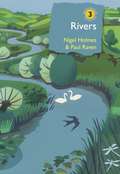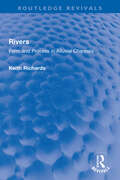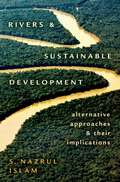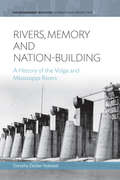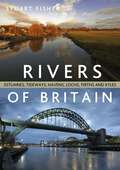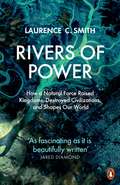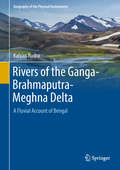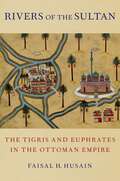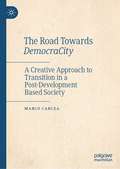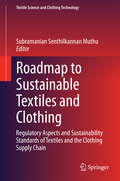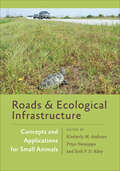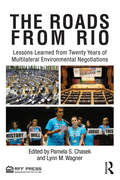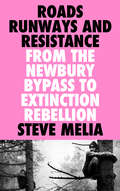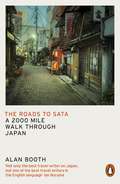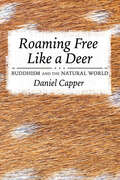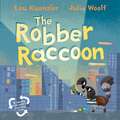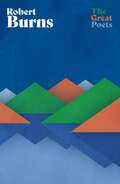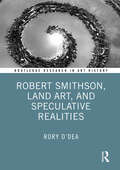- Table View
- List View
Rivers: A natural and not-so-natural history (British Wildlife Collection)
by Dr Paul Raven Nigel HolmesThroughout British history rivers have been of profound economic, social and cultural importance – yet as we see with increasing frequency they have the potential to wreak great destruction. This book describes the natural and not-so-natural changes that have affected British rivers since the last ice age and looks at the many plants and animals that live along, above and within them. Detailed case studies of the Meon, Dee and Endrick illustrate the incredibly varied nature of our river ecosystems, and the natural and human factors that make each one different. Written by two widely respected river ecologists, the book looks not only at rivers as they were and are but also at how they can be managed and cared for. Full of interesting facts and stunning images, Rivers is essential reading for anyone professionally involved in rivers and for the naturalist, conservationist and layman alike. It is the one book you need to understand this singularly important and often contentious feature of the British landscape.
Rivers: A natural and not-so-natural history (British Wildlife Collection)
by Dr Paul Raven Nigel HolmesThroughout British history rivers have been of profound economic, social and cultural importance – yet as we see with increasing frequency they have the potential to wreak great destruction. This book describes the natural and not-so-natural changes that have affected British rivers since the last ice age and looks at the many plants and animals that live along, above and within them. Detailed case studies of the Meon, Dee and Endrick illustrate the incredibly varied nature of our river ecosystems, and the natural and human factors that make each one different. Written by two widely respected river ecologists, the book looks not only at rivers as they were and are but also at how they can be managed and cared for. Full of interesting facts and stunning images, Rivers is essential reading for anyone professionally involved in rivers and for the naturalist, conservationist and layman alike. It is the one book you need to understand this singularly important and often contentious feature of the British landscape.
Rivers: One man and his dog paddle into the heart of Britain
by Griff Rhys JonesIn punts canoes and rowing boats, Griff Rhys Jones takes us on a tour of Britain's beautiful and extraordinary rivers. He battles through the gorges and waterfalls of Scotland's wild mountains, drifts across the plains of East Anglia and plunges into the Wye, exploring the legends and stories of our rivers on the way. How did man harness the power of water in feats of engineering like the Manchester Ship Canal, or the fountains at Chatsworth pr the weirs of Hertfordshire? What's it like to fall through a canyon in the Highlands, snorkel through a bog, slalom down a rapid or ride the Severn Bore? How were rivers an inspiration for Constable and the hermits of Bridgnorth? Griff investigates the love affair between cities and rivers from Liverpool's Mersey to London's Lea. From reminiscing about childhood holidays on the Suffolk Stour to taking the plunge on a wintry morning in the Tay as it rushes through Perth, Griff shares his person journeys along the river systems of Britain - always accompanied by Cadbury the faithful water dog.
Rivers: Form and Process in Alluvial Channels (Routledge Revivals)
by Keith RichardsOriginally published in 1982, this book presents a detailed review of alluvial river form and process and integrates the distinct but related approaches of geomorphologists, geologists and engineers to the subject. It outlines the environmental catchment factors that control the development of channel equilibrium and provides a detailed account of the sediment transport processes that represent the physical mechanisms by which channel adjustment occurs. Where possible it evaluates theoretical analyses in the context of the empirical evidence. Rivers should prove a valuable textbook for geomorphology students on advanced undergraduate courses on river behaviour and will also be of interest to students of hydraulics and sedimentology and to those concerned with civil and environmental engineering, river management and channel design, maintenance and management in the water industry
Rivers: Form and Process in Alluvial Channels (Routledge Revivals)
by Keith RichardsOriginally published in 1982, this book presents a detailed review of alluvial river form and process and integrates the distinct but related approaches of geomorphologists, geologists and engineers to the subject. It outlines the environmental catchment factors that control the development of channel equilibrium and provides a detailed account of the sediment transport processes that represent the physical mechanisms by which channel adjustment occurs. Where possible it evaluates theoretical analyses in the context of the empirical evidence. Rivers should prove a valuable textbook for geomorphology students on advanced undergraduate courses on river behaviour and will also be of interest to students of hydraulics and sedimentology and to those concerned with civil and environmental engineering, river management and channel design, maintenance and management in the water industry
Rivers and Sustainable Development: Alternative Approaches and Their Implications
by S. Nazrul IslamRivers are a vital component of ecology-the earth's hydrological cycle depends on them. However, across the world, rivers are under stress and even in crisis. With rising populations, the demand for river water is increasing. Many rivers fail to reach the sea because of excessive withdrawal of water, and many other rivers are heading toward the same fate. Conflicts over river water are increasing, and climate change is making matters worse. River policies pursued so far are often aggravating these challenges rather than solving them. Yet, sustainable development requires healthy rivers. Urgent change in the approach and policies toward rivers is therefore required. In this book, Nazrul Islam points to the ways in which river policies need to change to ensure sustainable development. He offers a new conceptual framework, using such concepts as the Commercial and Cordon approaches to rivers and their opposite, the Ecological and Open approaches. He shows that while the former generally work against sustainability, the latter are conducive to sustainable development. The book illustrates this reality by drawing upon worldwide experience regarding rivers. Going forward, river policies therefore should be based on Ecological and Open approaches. Islam argues further that the use of the new conceptual framework offered in this book can help to connect the river related discussion of experts with that of activists. It can thus help to move the discussion of river policies from the narrow confines of experts to the wider arena of the public, who should have a greater role in formulation of river policies in order to safeguard public interests and ensure sustainability. The book serves as a valuable guide for those interested in learning about river policy changes necessary to promote sustainable development.
Rivers and Sustainable Development: Alternative Approaches and Their Implications
by S. Nazrul IslamRivers are a vital component of ecology-the earth's hydrological cycle depends on them. However, across the world, rivers are under stress and even in crisis. With rising populations, the demand for river water is increasing. Many rivers fail to reach the sea because of excessive withdrawal of water, and many other rivers are heading toward the same fate. Conflicts over river water are increasing, and climate change is making matters worse. River policies pursued so far are often aggravating these challenges rather than solving them. Yet, sustainable development requires healthy rivers. Urgent change in the approach and policies toward rivers is therefore required. In this book, Nazrul Islam points to the ways in which river policies need to change to ensure sustainable development. He offers a new conceptual framework, using such concepts as the Commercial and Cordon approaches to rivers and their opposite, the Ecological and Open approaches. He shows that while the former generally work against sustainability, the latter are conducive to sustainable development. The book illustrates this reality by drawing upon worldwide experience regarding rivers. Going forward, river policies therefore should be based on Ecological and Open approaches. Islam argues further that the use of the new conceptual framework offered in this book can help to connect the river related discussion of experts with that of activists. It can thus help to move the discussion of river policies from the narrow confines of experts to the wider arena of the public, who should have a greater role in formulation of river policies in order to safeguard public interests and ensure sustainability. The book serves as a valuable guide for those interested in learning about river policy changes necessary to promote sustainable development.
Rivers, Memory, And Nation-building: A History of the Volga and Mississippi Rivers (Environment in History: International Perspectives #5)
by Dorothy Zeisler-VralstedRivers figure prominently in a nation’s historical memory, and the Volga and Mississippi have special importance in Russian and American cultures. Beginning in the pre-modern world, both rivers served as critical trade routes connecting cultures in an extensive exchange network, while also sustaining populations through their surrounding wetlands and bottomlands. In modern times, “Mother Volga” and the “Father of Waters” became integral parts of national identity, contributing to a sense of Russian and American exceptionalism. Furthermore, both rivers were drafted into service as the means to modernize the nation-state through hydropower and navigation. Despite being forced into submission for modern-day hydrological regimes, the Volga and Mississippi Rivers persist in the collective memory and continue to offer solace, recreation, and sustenance. Through their histories we derive a more nuanced view of human interaction with the environment, which adds another lens to our understanding of the past.
Rivers of Britain: Estuaries, Tideways, Havens, Lochs, Firths and Kyles
by Stuart FisherBritain's rivers deserve to be better known. Teeming withwildlife, steeped in history, sporting bridges, docks and stunningarchitecture, not to mention supporting riverside pubs, waterways museums and avariety of places of interest, they are the country's essential arteries,connecting inland Britain with the sea.Covering Britain's best known tidal rivers (the Avon,Severn, Dee, Mersey, Tyne and Thames), to the picturesque rural Camel, Wye,Orwell and Crouch, as well as the industrial rivers of the Medway, Tyne andClyde, right down to the smallest and lesser known of Britain's tidalwaterways, this is a fascinating and comprehensive guide, packed with maps,colour photographs and interesting facts about the lifeblood of our country.Of interest to sailors, fishermen, motorised craft andcanoeists keen to discover beautiful unfrequented spots, stopping points,places of interest, riverside pubs and lookout points, as well as practicalinformation on rapids, weirs and nearby towns and car parks, it will alsointerest walkers, cyclists, families and holidaymakers discovering the localhistory, folklore, riverside architecture and places to take river trips.
Rivers of Power: How a Natural Force Raised Kingdoms, Destroyed Civilizations, and Shapes Our World
by Laurence C. Smith'As fascinating as it is beautifully written' JARED DIAMOND, Pulitzer Prize-winning author of Guns, Germs and SteelRivers, more than any road, technology or political event, have shaped the course of civilization. Rivers have opened frontiers, defined borders, supported trade, generated energy and fed billions. Most of our greatest cities stand on river banks or deltas, and our quest for mastery has spurred staggering advances in engineering, science and law. Rivers and their topographic divides have shaped the territories of nations and the migration of peoples, and yet - as their resources become ever more precious - can foster cooperation even among enemy states. And even as they become increasingly domesticated, they remain a formidable global force: these vast arterial powers promote life but are capable of destroying everything in their path.From ancient Egypt to our growing contemporary metropolises, Rivers of Power reveals why rivers matter so profoundly to human civilization, and how they continue to be indispensable to our societies and wellbeing.'Takes readers on a tour of the world's great rivers - past, present and future. The result is fascinating, eye-opening, sometimes alarming, and ultimately inspiring' Elizabeth Kolbert, Pulitzer Prize-winning author of The Sixth Extinction'A tour de force ... From Herodotus musing on the Nile to the dam makers of modern China, this is their story' Fred Pearce, author of When the Rivers Run Dry
Rivers of the Ganga-Brahmaputra-Meghna Delta: A Fluvial Account of Bengal (Geography of the Physical Environment)
by Kalyan RudraThis is the first comprehensive book on the rivers of the Ganga-Brahmaputra-Meghna delta. This volume covers all aspects of this highly populated region including land conflicts and environmental impacts such as the Indo-Bangladesh conflict over sharing of trans-boundary water. This book addresses the topic from a highly interdisciplinary perspective covering areas of geography, geology, environment, history, archaeology, sociology and politics of the Bengal region.The book appeals to a wide range of audiences from India, Bangladesh and the international community. The style of presentation makes it easily suitable for students, researchers and interested laymen.
Rivers of the Sultan: The Tigris and Euphrates in the Ottoman Empire
by Faisal H. HusainThe Tigris and Euphrates rivers run through the heart of the Middle East and merge in the area of Mesopotamia known as the "cradle of civilization." In their long and volatile political history, the sixteenth century ushered in a rare era of stability and integration. A series of military campaigns between the Mediterranean Sea and the Persian Gulf brought the entirety of their flow under the institutional control of the Ottoman Empire, then at the peak of its power and wealth. Rivers of the Sultan tells the history of the Tigris and Euphrates during the early modern period. Under the leadership of Sultan Süleyman I, the rivers became Ottoman from mountain to ocean, managed by a political elite that pledged allegiance to a single household, professed a common religion, spoke a lingua franca, and received orders from a central administration based in Istanbul. Faisal Husain details how Ottoman unification institutionalized cooperation among the rivers' dominant users and improved the exploitation of their waters for navigation and food production. Istanbul harnessed the energy and resources of the rivers for its security and economic needs through a complex network of forts, canals, bridges, and shipyards. Above all, the imperial approach to river management rebalanced the natural resource disparity within the Tigris-Euphrates basin. Istanbul regularly organized shipments of grain, metal, and timber from upstream areas of surplus in Anatolia to downstream areas of need in Iraq. Through this policy of natural resource redistribution, the Ottoman Empire strengthened its presence in the eastern borderland region with the Safavid Empire and fended off challenges to its authority. Placing these world historic bodies of water at its center, Rivers of the Sultan reveals intimate bonds between state and society, metropole and periphery, and nature and culture in the early modern world.
Rivers of the Sultan: The Tigris and Euphrates in the Ottoman Empire
by Faisal H. HusainThe Tigris and Euphrates rivers run through the heart of the Middle East and merge in the area of Mesopotamia known as the "cradle of civilization." In their long and volatile political history, the sixteenth century ushered in a rare era of stability and integration. A series of military campaigns between the Mediterranean Sea and the Persian Gulf brought the entirety of their flow under the institutional control of the Ottoman Empire, then at the peak of its power and wealth. Rivers of the Sultan tells the history of the Tigris and Euphrates during the early modern period. Under the leadership of Sultan Süleyman I, the rivers became Ottoman from mountain to ocean, managed by a political elite that pledged allegiance to a single household, professed a common religion, spoke a lingua franca, and received orders from a central administration based in Istanbul. Faisal Husain details how Ottoman unification institutionalized cooperation among the rivers' dominant users and improved the exploitation of their waters for navigation and food production. Istanbul harnessed the energy and resources of the rivers for its security and economic needs through a complex network of forts, canals, bridges, and shipyards. Above all, the imperial approach to river management rebalanced the natural resource disparity within the Tigris-Euphrates basin. Istanbul regularly organized shipments of grain, metal, and timber from upstream areas of surplus in Anatolia to downstream areas of need in Iraq. Through this policy of natural resource redistribution, the Ottoman Empire strengthened its presence in the eastern borderland region with the Safavid Empire and fended off challenges to its authority. Placing these world historic bodies of water at its center, Rivers of the Sultan reveals intimate bonds between state and society, metropole and periphery, and nature and culture in the early modern world.
The Road Towards DemocraCity: A Creative Approach to Transition in a Post-Development Based Society
by Marco CarceaThis book discusses the challenges faced by the homo resaliens and his need for a transition to a more sustainable social, economic, and environmental system. It fills a gap in the existing literature and provides a new perspective by changing the etymology of the word resilience: no more resiliere, but resalio. By comparing and analysing the relevant literature, the author has coined the term homo resaliens (resilient man), in contrast to the failure of the homo oeconomicus, the corruption of the homo politicus, the incompleteness of homo sustinens, and the limits of homo ecologicus. Opening a new debate in which the role of academia and res publica are fundamental to safeguard human communities and future generations, this book will greatly assist governments that wish to understand the socio-political and economic implication of resilience in terms of social inclusiveness and long term social and environmental sustainability.
Roadmap to Sustainable Textiles and Clothing: Regulatory Aspects and Sustainability Standards of Textiles and the Clothing Supply Chain (Textile Science and Clothing Technology)
by Subramanian Senthilkannan MuthuThis book covers the elements involved in achieving sustainability in textiles and clothing sector. The chapters covered in three volumes of this series title cover all the distinctive areas earmarked for achieving sustainable development in textiles and clothing industry. This third volume highlights the areas pertaining to the regulatory aspects and sustainability standards applicable to textiles and clothing supply chain. There are various standards earmarked for measuring the environmental impacts and sustainability of textile products. There are also plenty of certification schemes available along with the index systems applicable to textile sector. Brands and manufactures are also venturing into new developments to achieve sustainable development in textile sector. This third volume addresses all these important aspects.
Roads and Ecological Infrastructure: Concepts and Applications for Small Animals (Wildlife Management and Conservation)
by Kimberly M. Andrews Priya Nanjappa Seth P. RileyFew of us think twice about driving on roads. Yet the very presence of roads and the act of driving on them can impact the ecological infrastructure that supports an animal’s daily life. What chance does a turtle have of successfully laying its eggs when it needs to traverse a busy highway? Is it realistic to expect small mammals to breed when an interstate thoroughfare subdivides their population? These are the sorts of challenges faced by small, often slow-moving, animals, challenges that road engineers and ecologists are trying to address.For countless small species, vehicles traveling at high speeds are nothing less than missiles shooting across migration pathways. For too many animals, the danger can lead to the loss of populations, in part because they simply are not programmed to react to traffic. Salamanders faced with a two-lane road between the forest and their aquatic breeding site, for example, will typically cross that road regardless of the congestion. The result can be hundreds of flattened animals in a single night.Roads and Ecological Infrastructure is the first book to focus on reducing conflict between roads and small animals. Highlighting habitat connections and the challenges and solutions from both transportation and ecological perspectives, the volume covers various themes, including animal behavior related to roads and design approaches to mitigate the negative effects of roads on wildlife. The chapter authorsâ€�from transportation experts to university researchersâ€�each promote a goal of realistic problem solving. Conceptual and practical, this book will influence the next decade or more of road design in ecologically sensitive areas and should prevent countless unnecessary wildlife fatalities.
The Roads from Rio: Lessons Learned from Twenty Years of Multilateral Environmental Negotiations
by Pamela S. Chasek Lynn M. WagnerAt the 1992 United Nations Conference on Environment and Development, popularly known as the Rio Earth Summit, the world’s leaders constructed a new "sustainable development" paradigm that promised to enhance environmentally sound economic and social development. Twenty years later, the proliferation of multilateral environmental agreements points to an unprecedented achievement, but is worth examining for its accomplishments and shortcomings. This book provides a review of twenty years of multilateral environmental negotiations (1992-2012). The authors have participated in most of these negotiating processes and use their first-hand knowledge as writers for the International Institute for Sustainable Development’s Earth Negotiations Bulletin as they illustrate the changes that have taken place over the past twenty years. The chapters examine the proliferation of meetings, the changes in the actors and their roles (governments, nongovernmental organizations, secretariats), the interlinkages of issues, the impact of scientific advice, and the challenges of implementation across negotiating processes, including the Framework Convention on Climate Change, the Convention to Combat Desertification, the Convention on Biological Diversity, the Commission on Sustainable Development, the UN Forum on Forests, the chemicals conventions (Stockholm, Basel and Rotterdam), the Montreal Protocol on Substances that Deplete the Ozone Layer, the Convention on International Trade in Endangered Species, the Convention on Migratory Species and the International Treaty on Plant Genetic Resources for Food and Agriculture.
The Roads from Rio: Lessons Learned from Twenty Years of Multilateral Environmental Negotiations
by Pamela Chasek Lynn M. WagnerAt the 1992 United Nations Conference on Environment and Development, popularly known as the Rio Earth Summit, the world’s leaders constructed a new "sustainable development" paradigm that promised to enhance environmentally sound economic and social development. Twenty years later, the proliferation of multilateral environmental agreements points to an unprecedented achievement, but is worth examining for its accomplishments and shortcomings. This book provides a review of twenty years of multilateral environmental negotiations (1992-2012). The authors have participated in most of these negotiating processes and use their first-hand knowledge as writers for the International Institute for Sustainable Development’s Earth Negotiations Bulletin as they illustrate the changes that have taken place over the past twenty years. The chapters examine the proliferation of meetings, the changes in the actors and their roles (governments, nongovernmental organizations, secretariats), the interlinkages of issues, the impact of scientific advice, and the challenges of implementation across negotiating processes, including the Framework Convention on Climate Change, the Convention to Combat Desertification, the Convention on Biological Diversity, the Commission on Sustainable Development, the UN Forum on Forests, the chemicals conventions (Stockholm, Basel and Rotterdam), the Montreal Protocol on Substances that Deplete the Ozone Layer, the Convention on International Trade in Endangered Species, the Convention on Migratory Species and the International Treaty on Plant Genetic Resources for Food and Agriculture.
Roads, Runways and Resistance: From the Newbury Bypass to Extinction Rebellion
by Steve MeliaFrom the anti-roads protests of the 1990s to HS2 and Extinction Rebellion, conflict and protest have shaped the politics of transport. In 1989, Margaret Thatcher's government announced 'the biggest road-building programme since the Romans.' This is the inside story of the thirty tumultuous years that have followed. Roads, Runways and Resistance draws on over 50 interviews with government ministers, advisors and protestors - many of whom, including 'Swampy', speak here for the first time about the events they describe. It is a story of transport ministers undermined by their own Prime Ministers, protestors attacked or quietly supported by the police, and smartly-dressed protestors who found a way onto the roof of the Houses of Parliament. Today, as a new wave of road building and airport expansion threatens to bust Britain's carbon budgets, climate change protestors find themselves on a collision course with the government. Melia asks, what difference did the protests of the past make? And what impacts might today's protest movements have on the transport of the future?
Roads, Runways and Resistance: From the Newbury Bypass to Extinction Rebellion
by Steve MeliaFrom the anti-roads protests of the 1990s to HS2 and Extinction Rebellion, conflict and protest have shaped the politics of transport. In 1989, Margaret Thatcher's government announced 'the biggest road-building programme since the Romans.' This is the inside story of the thirty tumultuous years that have followed. Roads, Runways and Resistance draws on over 50 interviews with government ministers, advisors and protestors - many of whom, including 'Swampy', speak here for the first time about the events they describe. It is a story of transport ministers undermined by their own Prime Ministers, protestors attacked or quietly supported by the police, and smartly-dressed protestors who found a way onto the roof of the Houses of Parliament. Today, as a new wave of road building and airport expansion threatens to bust Britain's carbon budgets, climate change protestors find themselves on a collision course with the government. Melia asks, what difference did the protests of the past make? And what impacts might today's protest movements have on the transport of the future?
The Roads to Sata: A 2000-mile walk through Japan
by Alan Booth'A memorable, oddly beautiful book' Wall Street Journal'A marvellous glimpse of the Japan that rarely peeks through the country's public image' Washington PostOne sunny spring morning in the 1970s, an unlikely Englishman set out on a pilgrimage that would take him across the entire length of Japan. Travelling only along small back roads, Alan Booth travelled on foot from Soya, the country's northernmost tip, to Sata in the extreme south, traversing three islands and some 2,000 miles of rural Japan. His mission: 'to come to grips with the business of living here,' after having spent most of his adult life in Tokyo.The Roads to Sata is a wry, witty, inimitable account of that prodigious trek, vividly revealing the reality of life in off-the-tourist-track Japan. Journeying alongside Booth, we encounter the wide variety of people who inhabit the Japanese countryside - from fishermen and soldiers, to bar hostesses and school teachers, to hermits, drunks and the homeless. We glimpse vast stretches of coastline and rambling townscapes, mountains and motorways; watch baseball games and sunrises; sample trout and Kilamanjaro beer, hear folklore, poems and smutty jokes. Throughout, we enjoy the wit and insight of a uniquely perceptive guide, and more importantly, discover a new face of an often-misunderstood nation.
Roaming Free Like a Deer: Buddhism and the Natural World
by Daniel CapperBy exploring lived ecological experiences across seven Buddhist worlds from ancient India to the contemporary West, Roaming Free Like a Deer provides a comprehensive, critical, and innovative examination of the theories, practices, and real-world results of Buddhist environmental ethics. Daniel Capper clarifies crucial contours of Buddhist vegetarianism or meat eating, nature mysticism, and cultural speculations about spirituality in nonhuman animals. Buddhist environmental ethics often are touted as useful weapons in the fight against climate change. However, two formidable but often overlooked problems with this perspective exist. First, much of the literature on Buddhist environmental ethics uncritically embraces Buddhist ideals without examining the real-world impacts of those ideals, thereby sometimes ignoring difficulties in terms of practical applications. Moreover, for some understandable but still troublesome reasons, Buddhists from different schools follow their own environmental ideals without conversing with other Buddhists, thereby minimizing the abilities of Buddhists to act in concert on issues such as climate change that demand coordinated large-scale human responses. With its accessible style and personhood ethics orientation, Roaming Free Like a Deer should appeal to anyone who is concerned with how human beings interact with the nonhuman environment.
The Robber Raccoon
by Lou KuenzlerRosie Raccoon was up to no goodout and about in a grand neighbourhood.It seems Rosie is up to no good as she breaks into the houses of Bear, Flamingo and Snake, but when Officer Skunk catches her in the act all she has taken is junk! But Rosie has a plan to recycle these treasures and make something new . . .With a topical environmental theme, Lou's fantastic rhyming text and Julia's adorable illustrations, this picture book will be irresistible to young readers.
Robert Burns: A superb collection from Scotland’s finest lyrical poet (The Great Poets)
by Robert Burns'Oh would some power the gift give us, to see ourselves as others see us!' Robert BurnsRobert Burns, poet and lyricist, also known as Rabbie Burns, is widely regarded as the National Poet of Scotland - and much of his work has become part of everyday modern language:'The best laid schemes o' mice and men...''To see her is to love her...'Often credited with writing the lyrics for Auld Lang Syne, he almost single-handedly inspired the movement that preserved Scottish music and lyrics which had been handed down the generations vocally for centuries, thereby maintaining Scots culture and language.A cultural icon and pioneer of the Romantic movement, Burns was chosen as the greatest Scot in a 2009 poll. This collection includes some of his best-loved, most beautiful work.'Now's the day, now's the hour' Robert Burns
Robert Smithson, Land Art, and Speculative Realities (Routledge Research in Art History)
by Rory O'DeaThis book explores the ways Robert Smithson’s art revealed and defamiliarized the constructs of rational reality in order to allow radically speculative alternatives to emerge. In this way, his art is conceived as a true fiction that eradicates a false reality. By tracing the web of correspondences between Smithson and science fictional, speculative and mystical modes of thought, Rory O’Dea explores the aesthetic encounters engendered by his art as a means to warp the contours of reality and loosen the boundaries of being human. Given the current and impending catastrophes of the Anthropocene, which represents the ever-expanding planetary shadow cast by humanism, the possibility of being other-than-human posited by Smithson’s art is a matter of urgent concern. The book will be of interest to scholars working in art history, contemporary art, American studies and environmental humanities.
